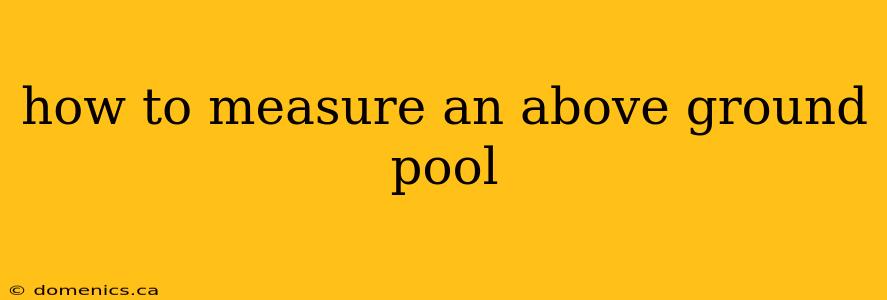Knowing the dimensions of your above-ground pool is crucial for various reasons, from buying the right pool cover to calculating the amount of water needed for filling. Accurately measuring your pool ensures you purchase the correct supplies and avoid costly mistakes. This comprehensive guide will walk you through the process, covering different pool shapes and potential challenges.
Why Measure Your Above Ground Pool?
Accurately measuring your above-ground pool is essential for several reasons:
- Purchasing the right cover: An improperly sized cover won't protect your pool effectively.
- Calculating water volume: This is necessary for chemical treatment and filling.
- Ordering pool accessories: Ladders, cleaners, and other accessories are often sized to fit specific pool dimensions.
- Planning landscaping: You'll need accurate measurements for proper placement and surrounding features.
- Pool maintenance: Knowing your pool's size aids in determining the appropriate amount of cleaning supplies.
Tools You'll Need
Before you start, gather these essential tools:
- Measuring tape: A long, flexible tape measure (at least 25 feet) is ideal.
- Notebook and pen: Record your measurements to avoid errors.
- Calculator: Useful for calculating area and volume.
- Assistant (optional): Having someone to help hold the tape measure can make the process easier, especially for larger pools.
Measuring Different Pool Shapes
Above-ground pools come in various shapes. Here's how to measure the most common types:
1. Round Pools
Measuring a round pool is straightforward:
- Diameter: Measure across the widest part of the pool, passing through the center. This is the diameter.
- Depth: Measure the depth at multiple points – center, shallow end, and deep end (if applicable). Average the measurements for an accurate depth.
Remember to note the depth from the pool floor to the top of the waterline.
2. Oval Pools
Oval pools require two measurements:
- Length: Measure the longest distance across the pool.
- Width: Measure the widest distance across the pool.
- Depth: As with round pools, measure the depth at several points and average the results.
Ensure you're measuring the inside dimensions of the pool walls, not the outer dimensions of the structure.
3. Rectangular or Square Pools
Rectangular and square pools are measured similarly:
- Length: Measure the longest side.
- Width: Measure the shortest side.
- Depth: Measure depth at multiple points and average for accuracy. Note any variations in depth.
Record the inside measurements.
4. Irregularly Shaped Pools
Pools with unique shapes require more careful attention to detail:
- Break it down: Divide the pool into smaller, more manageable sections (squares, rectangles, or triangles).
- Measure each section: Measure the length, width, and depth of each section individually.
- Calculate the area: Use appropriate geometric formulas to calculate the area of each section.
- Add the areas: Sum the areas of all sections to determine the total pool area.
This method requires more mathematical calculation, but it's the most accurate way to measure an irregularly-shaped pool. Consider using graph paper to sketch the pool and record your measurements.
Addressing Potential Challenges
- Uneven Ground: If your pool sits on uneven ground, your measurements might be slightly inaccurate. Take multiple measurements at different points and average them.
- In-ground Features: Steps or benches will affect your measurements. Carefully measure around these features and adjust your calculations accordingly.
- Pool Liner: Be sure you are measuring the inside of the pool liner to get the actual usable swimming space. The liner may extend slightly beyond the structure.
Calculating Water Volume
Once you have the dimensions, you can calculate the volume of water your pool holds. This calculation depends on the pool's shape. Online calculators are readily available that can perform this calculation for you, but be sure you are using the inside dimensions that you previously measured.
Important Note: Always double-check your measurements before purchasing any pool accessories or supplies. A small error in measurement can have significant consequences.
By following these steps, you can accurately measure your above-ground pool, ensuring you have the right information for all your pool needs. Remember accuracy is key – take your time and double-check your work!
